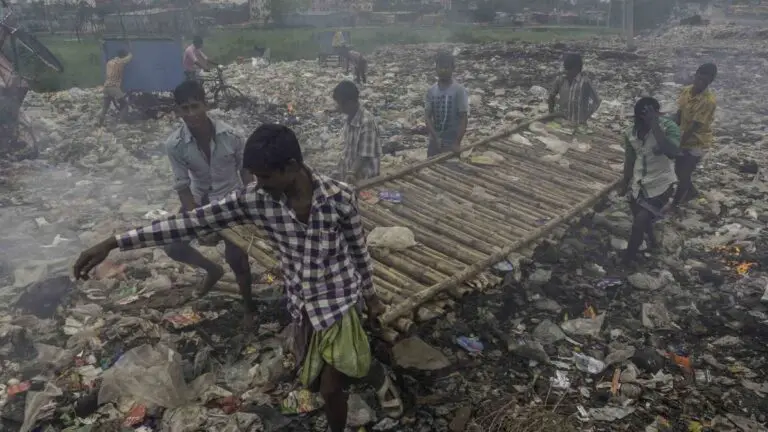Population Problem in Bangladesh Article
The article “Population Problem in Bangladesh” is about the population problem in Bangladesh. The author of the article, Dr. M. A. Haq, states that the population of Bangladesh is increasing at an alarming rate and that the government is not doing anything to solve the problem. He also says that the government should take measures to control the population growth.
Bangladesh is one of the world’s most densely populated countries, with an estimated population of 160 million people in an area of just 147,570 square kilometers. The country’s high population density is exacerbated by its topography; two-thirds of Bangladesh is flood-prone river delta lowlands. With little arable land and a limited supply of potable water, Bangladesh faces significant challenges in meeting the needs of its growing population.
The government has made family planning a priority, but progress has been slow due to cultural norms and a lack of access to services. In 2010, the government launched a $2 billion initiative to improve maternal and child health, provide free family planning services, and expand access to contraception. These efforts have begun to pay off; between 2011 and 2016, Bangladesh’s total fertility rate declined from 3.3 to 2.2 births per woman.
However, with a large youth bulge – nearly half of the population is under age 25 – Bangladesh’s population is expected to continue growing for several decades.
The challenges posed by rapid population growth are compounded by poverty and inequality. Nearly one-third of the population lives below the national poverty line (US$1.90 per day), and almost two-thirds are “food insecure” (i.e., they do not have reliable access to enough nutritious food).
Women are particularly vulnerable; nearly 60 percent of Bangladeshi women are illiterate, and nearly half live in poverty. Gender inequality limits women’s economic opportunities and contributes to poor health outcomes for both women and children. For example, maternal mortality rates are relatively high at 176 deaths per 100,000 live births (compared to global average of 210 deaths per 100,000 live births).
The combination of rapid population growth and persistent poverty creates significant challenges for Bangladeshis striving to improve their standard of living. Overcrowding strains resources such as water supplies and healthcare facilities; meanwhile, environmental degradation – caused by deforestation , overfishing , air pollution , etc.– diminishing quality of life further still .
The government has taken some steps to address these problems , but more needs be done ensure that all Bangladeshis can enjoy a safe , healthy , prosperous future .
Why Does Bangladesh Have the Problem of Overpopulation?
Bangladesh is one of the most densely populated countries in the world, with a population of over 163 million people crammed into an area of just 147,570 square kilometers. That’s a population density of over 1,100 people per square kilometer – more than 10 times that of the United States.
The high population density is not evenly distributed across Bangladesh though.
More than half of the population lives in rural areas, while the urban population is growing rapidly. The capital city Dhaka is by far the largest metropolis, with a population of around 18 million people.
There are several reasons for Bangladesh’s high population density.
Firstly, the country has a very young population – almost two-thirds are under 25 years old. Secondly, life expectancy is relatively low at just over 64 years for men and 67 years for women. This means that more people are likely to die at a younger age, leaving behind large families.
Lastly, and perhaps most importantly, Bangladesh has one of the highest fertility rates in the world at 2.3 children per woman. This is well above the “replacement level” fertility rate of 2.1 children per woman needed to keep a country’s population stable in the long-term.
All these factors combine to create a situation where Bangladesh’s population continues to grow rapidly despite efforts to reduce poverty and improve living standards.
The government has introduced various family planning initiatives over the years but they have had little impact on slowing downpopulation growth..
What are the Population Problem?
There are a number of issues that can be classified as population problems. Some of the more common ones include:
– Lack of access to clean water and sanitation facilities
– Poor nutrition and health care
– Overpopulation in certain areas leading to environmental degradation
– Gender inequality and violence against women
– Child labour and exploitation
What are the 4 Main Challenges of Population?
There are four main challenges to population: food, water, energy and climate change.
Food: The world’s population is projected to reach 9.1 billion by 2050, up from 7.3 billion today. That means the planet will have to produce about 60 percent more food than it does now just to feed everyone.
But that’s not all – as incomes rise and diets change, people are consuming more meat and dairy, which takes more land and water to produce. At the same time, farmers are being hit by droughts, floods and other extreme weather events made worse by climate change. All of this means that ensuring everyone has enough to eat in a future with a rapidly growing population is a huge challenge.
Water: With more people on the planet comes more demand for water – for drinking, irrigation and industry. Already, nearly 1 billion people do not have access to safe drinking water and 2.7 billion live in areas where water is scarce for at least one month of the year. As populations grow and climates change ( leading to longer droughts or more intense floods), meeting the world’s water needs is only going to get harder.
Energy: Population growth brings with it increased demand for energy – for lighting homes, powering factories and so on. Today, most of the world’s energy comes from fossil fuels like coal and oil, which release greenhouse gases when burned. These emissions are contributing to climate change , which is making extreme weather events like heatwaves , hurricanes and floods more frequent and intense .
To meet rising energy needs while avoiding dangerous levels of climate change , we need to find ways of generating electricity that don’t involve burning fossil fuels .
Climate Change: Climate change is one of the biggest challenges facing humanity today . It is caused by emissions of greenhouse gases like carbon dioxide , which trap heat in the atmosphere and cause global temperatures to rise .
This leads to all sorts of problems like melting ice caps , sea level rise and increases in extreme weather events . Climate change also threatens our ability to produce enough food and fresh water to meet the needs of a growing population . Tackling climate change will require big changes in how we generate energy , how we use land and how we live our lives .
What are the Problems Related to High Population Density in Bangladesh?
The population of Bangladesh is currently around 163 million people, making it the 8th most populous country in the world. The majority of the population (around 80%) live in rural areas, with the remaining 20% living in urban areas. The population density of Bangladesh is very high, at around 1,200 people per square kilometer.
This means that Bangladesh has one of the highest population densities in the world.
There are a number of problems associated with high population density in Bangladesh. One of the main problems is that there is not enough land to go around.
With such a high population density, each person only has a very small amount of space to call their own. This can lead to overcrowding and a lack of privacy.
Another problem related to high population density is that it can put strain on resources such as food and water.
With so many people living in close proximity to each other, it is easy for scarce resources to become depleted quickly. This can lead to competition and conflict over these resources.
Finally, high population density can also have negative impacts on mental health.
When people are constantly living in close quarters with others, it can be difficult to find time and space for oneself. This can lead to feelings of isolation and anxiety.
How Bangladesh Fixes Population Problems
Population Problem in Bangladesh Composition 150 Words
The population of Bangladesh is about 161 million people, making it the 8th most populous country in the world. The high population density of 1,106 people per square kilometer makes Bangladesh the 4th most densely populated country. While the overall population growth rate has declined in recent years, it is still relatively high at 1.2%.
This means that the population is growing by about 2 million people each year.
The high population growth rate is due to a number of factors, including a young population (the median age is only 24 years old), a high fertility rate (3.3 children per woman), and limited access to contraception and family planning services. These factors combine to create a “perfect storm” for population growth.
The rapid population growth is putting immense pressure on Bangladesh’s resources and infrastructure. The country has limited land area and water resources, which are already under strain from overuse and pollution. The government is struggling to provide adequate housing, healthcare, education, and employment opportunities for its rapidly growing population.
As a result, many Bangladeshis live in poverty and poor health conditions.
The government has recognized the seriousness of the problem and has taken some steps to address it. In 2011, it launched a National Population Policy with the goal of reducing the total fertility rate to 2.1 children per woman by 2021-2030.
Population Problem in Bangladesh Composition for Class 7
In Bangladesh, the population problem is becoming more and more serious. The population of Bangladesh is now about 161 million. It is projected to reach 230 million by 2050.
The high growth rate is due to a combination of factors, such as high birth rates, low death rates, and large numbers of people migrating from rural to urban areas.
The government has tried to control the population growth through a variety of means, including family planning programs and education campaigns. However, these efforts have not been successful in reducing the birth rate.
In fact, the birth rate has actually increased in recent years. This is due to a number of factors, including poverty, lack of access to contraception, and early marriage.
The growing population is putting strain on all aspects of society in Bangladesh.
The most obvious impact is on the country’s resources, such as food and water. With more mouths to feed, there is less food for everyone and prices are rising. The government is also struggling to provide adequate housing, healthcare, and education for all its citizens.
The population problem in Bangladesh is complex and requires urgent attention. Unless something is done to reduce the birth rate and improve living conditions for all its citizens, the problems associated with overpopulation will only get worse.
Population Problem in Bangladesh Assignment
Bangladesh is one of the most densely populated countries in the world, with a population of over 163 million people crammed into an area of just 147,570 square kilometers. That’s a population density of more than 1,100 people per square kilometer, which is about double the density of India.
The high population density is not evenly distributed throughout Bangladesh.
Most of the people live in the fertile Ganges delta region in the country’s southwest corner. The capital city of Dhaka is also located in this region and has a population of more than 10 million people.
The high population density puts immense pressure on Bangladesh’s limited resources and its fragile environment.
The country has very little forest cover and only 4% of its land area is classified as arable land. This means that there is very little room for further economic development or for absorbing any environmental shocks such as floods or cyclones.
The high population density also creates social problems such as overcrowding, crime and poverty.
More than 60% of Bangladeshis live below the national poverty line and many struggle to get by on less than $2 per day. Inadequate housing, sanitation and healthcare are also major problems in Bangladesh due to the large number of people living in such close proximity to each other.
Population Problem in Bangladesh Essay
In Bangladesh, the population problem is severe. The land area is very limited and the population is very dense. As a result, the country faces many problems related to overpopulation.
These problems include poverty, unemployment, environmental degradation, and social unrest.
The government of Bangladesh has taken some steps to address the population problem. It has implemented a family planning program and launched various campaigns to promote birth control.
However, these measures have not been successful in reducing the rate of population growth. The government needs to do more to solve this problem.
The population problem is one of the most serious issues facing Bangladesh today.
If it is not addressed effectively, it will lead to even more problems in the future.
Conclusion
The population of Bangladesh is currently around 160 million people, making it the 8th most populous country in the world. The population is projected to grow to around 200 million by 2050, making it the 4th most populous country. The high population growth rate is a major concern for Bangladesh, as the country faces many challenges in providing adequate resources and infrastructure for its growing population.
Overpopulation is putting strain on resources such as water, food, and energy, as well as healthcare and education. The government is working on initiatives to control population growth, but more needs to be done to address this critical issue.







